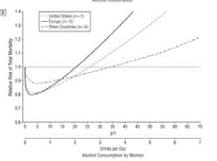A recent ‘Burden of Proof’ study summarises and evaluates the evidence on alcohol consumption’s effects on coronary artery disease (ischemic heart disease) has been published in the journal ‘Nature Communications.’ [1] [2] [3]
The study finds reduced heart disease risk with low to moderate drinking.
This study uses a method to pool estimates of 122 observational studies published between 1970 and January 2021, the authors find a J-shaped relationship which show that consumption of up to about 50g a day is associated with lower risk of coronary artery disease morbidity and mortality and heart attack deaths. In NZ 50g equates to five standard drinks a day which is higher than our safe drinking guidelines.
The size of the decrease differs by study design: a 5% decrease in risk among cohort studies and a 13% decrease in risk among case-control studies. They also find that the four included Mendelian randomization (MR) studies, which use genetic proxies instead of measuring alcohol consumption, do not show evidence of a relationship with coronary artery disease risk.
The NZ Ministry of Health guidelines for safe drinking are two standard drinks a day for women, and three standard drinks a day for men, with at least two alcohol-free days each week. A standard drink contains 10g of alcohol.
“This further confirms a large body of research that all things being equal, those that drink lightly to moderately live longer than those that do not drink at all”, says NZABC executive director Virginia Nicholls.
The J-curve shows that in many different populations, researchers have found people who drink light to moderate levels of beverage alcohol have a lower risk of death (all-cause mortality) during the period being studied, than people who do not drink at all or those who drink hazardously [4].
The findings from this Burden of Proof study have been fed into the larger Global Burden of Disease (GBD) framework for the calculation of alcohol-attributable coronary artery disease morbidity and mortality, and are reflected in the GBD data portal [5] and the most recent GBD 2021 Study Collaborators publication on attributable risk factors in The Lancet [6].
The NZ Health survey says that 84% of NZ adults (more than four out of five of us) are drinking beer, wine and spirits responsibly. This is an increase of 3% from last year (81% 2022) [7].
The NZ Health survey also shows the lowest rate of hazardous drinking [8] since the survey began – sitting at 16% of the adult population (18.7% 2022). “This reduction is significant and shows the change in the way that we are drinking.” Over the past year this equates to 110,000 fewer kiwis drinking in a harmful way. [9]
“It is important that everyone must evaluate the risks they face each day to inform their personal choices, from the foods they eat to the activities they enjoy and, of course, anyone with questions should speak to their healthcare professionals to better understand the impact of drinking on their individual health.”
About the New Zealand Alcohol Beverages Council
The NZ Alcohol Beverages Council is a pan-industry group that comments publicly on matters relating to the beer, wine, spirits and beverages industry. It focuses on supporting responsible alcohol consumption and wants to see a fair and balanced debate on alcohol regulation in New Zealand.
A J-shaped relationship between drinking and risk of death from all causes continues to be supported by studies:

Source: Di Castelnuovo, A. et al.(2006). Archives of Internal Medicine, 166(22), 2437-2445
References:
[1] Carr, S., Bryazka, D., McLaughlin, S. A., Zheng, P., Bahadursingh, S., Aravkin, A. Y., et al. (2024). A burden of proof study on alcohol consumption and ischemic heart disease. Nature Communications, 15(1), 4082. A burden of proof study on alcohol consumption and ischemic heart disease | Nature Communications, accessed 21 May 2024.
[2] This study is the first to detail an application of the Global Burden of Disease collaboration’s new Burden of Proof approach to alcohol consumption as a risk factor. To date, the approach has been applied to 21 other risk factors, including smoking, second hand smoke, and 14 dietary patterns. The approach assigns strength of evidence star ratings to risk=outcome relationships used in the Global Burden Disease framework and aims to facilitate comparison among them.
[3] This robust approach to examine the evidence and address several important potential biases affirm the results of previous research finding a J-shaped relationship between alcohol and IHD (Coronary Artery disease) in studies using traditional observational methods but not in newer methods, such as Mendelian randomization
[4] In other words, if we plot the lifespans of a population on a line across a horizontal axis, with those who don’t drink at all on the left, and those who drink more heavily to the right, there is a dip shortly after the beginning of the line which represents those who drink moderately because they live, on average, a little longer than non-drinkers. This is according to the vast majority of research which has been conducted now for decades.
[5] The global burden of disease data portal: VizHub – GBD Compare (healthdata.org)
[6] The Lancet: Global burden and strength of evidence for 88 risk factors in 204 countries and 811 subnational locations, 1990–2021: a systematic analysis for the Global Burden of Disease Study 2021 – The Lancet
[7] NZ Health annual survey December 2023: New Zealand Health Survey | Ministry of Health NZ
[8] Hazardous drinkers are those who obtain an AUDIT (alcohol use disorders identification test) score of 8 or more, representing an established pattern of drinking that carries a high risk of future damage to physical or mental health.
[9] NZ Health survey: This is an estimated 670,000 adults (22/23) (during 21/22: 780,000 adults). This is 110,000 fewer kiwis drinking in a harmful way.
